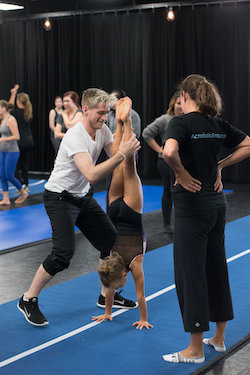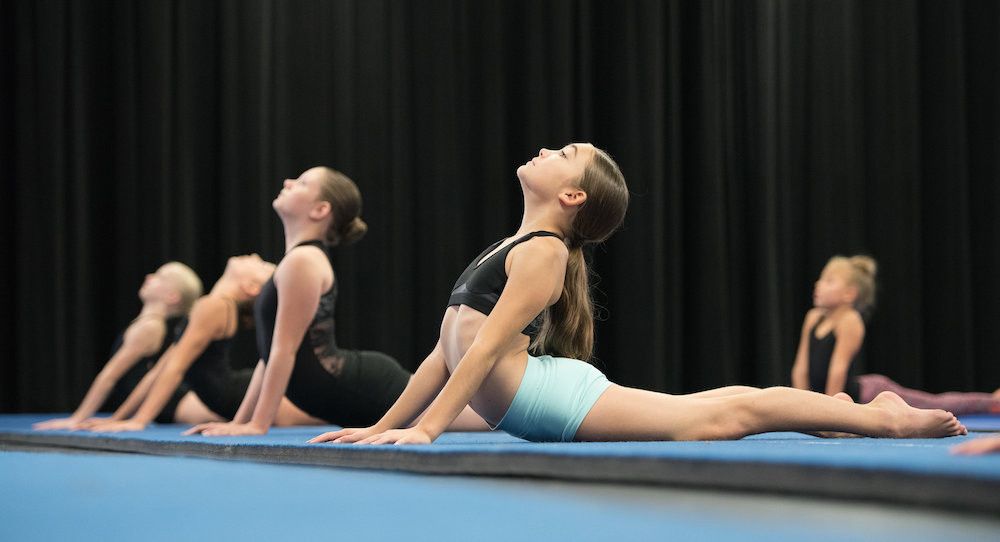The fusion of dance and acrobatics has undeniably transformed the landscape of dance routines. Fueled by the popularity of shows like So You Think You Can Dance and the dynamic energy of dance competitions, this blend of athleticism and artistry, often termed “Acrobatic Dance” or “acrodance,” has captivated audiences worldwide. While some initially questioned the place of acrobatics within dance, the innovative approach of Acrobatic Arts, launched in 2012 by Mandy Yip, has revolutionized dance education. This program empowers educators to teach “acrodance” safely, artistically, and with achievable progressions.
As a dance educator specializing in contemporary and jazz, the increasing demand from students to incorporate spectacular “tricks” into choreography is a familiar scenario. Inspired by captivating performances on television and social media platforms like Instagram, students are eager to execute complex acrobatic feats. However, ensuring the safety and artistic integrity of dance while integrating these challenging movements presents a significant pedagogical challenge. How can instructors responsibly train dancers in these skills and seamlessly weave them into choreography without compromising the narrative, emotional depth, and fluidity of the dance? Furthermore, the paramount concern remains: how to teach these acrobatic elements while preventing injuries?
The answer for many dance educators lies in specialized training programs, and for this author, the Acrobatic Arts teacher certification program, attended in Adelaide, proved to be a transformative experience.
The Rise of Acrobatic Dance in Dance Education
Acrobatic Arts distinguishes itself as a professionally structured syllabus program meticulously designed for teaching acrobatic dance. This discipline uniquely merges the expressive artistry and refined technique inherent in formal dance training with the demanding athleticism characteristic of acrobatics. This fusion creates a dynamic art form that expands the vocabulary of dance and offers dancers new avenues for physical expression and performance.
 Teachers undergoing Acrobatic Arts certification course, learning safe spotting techniques and acrobatic progressions.
Teachers undergoing Acrobatic Arts certification course, learning safe spotting techniques and acrobatic progressions.
Addressing the Need for Safe and Effective Acrobatic Dance Training
The intensive two-day certification course provided a comprehensive toolkit for teaching acrobatic dance safely and effectively. The curriculum extended beyond simply demonstrating exercises; it equipped teachers with the knowledge and practical skills to enhance dancers’ endurance, strength, and flexibility. Crucially, the program emphasized safe spotting techniques and progressive teaching methodologies for acrobatic and tumbling skills, making these challenging movements accessible and manageable for dancers of varying levels. The training incorporated practical sessions with students of diverse ages and skill levels, alongside opportunities for teachers to engage in the exercises themselves. These hands-on experiences were complemented by informative seminars covering essential topics such as anatomy, skill progressions, dance safety protocols, and the art of acrodance choreography. Leaving the course, there was a palpable sense of confidence and enthusiasm about integrating acrobatic dance into the studio curriculum. The practical application with students from Pivotal Dance and the structured syllabus, encompassing six levels within Module One, provided a robust framework for introducing acrodance. The excitement was undeniable.
Acrobatic Arts Certification: A Comprehensive Solution
Conversations with fellow dance educators who have already incorporated Acrobatic Arts into their studios revealed a range of unexpected benefits. The structured progressions inherent in the Acrobatic Arts syllabus offer a unique diagnostic advantage. By training dancers through these carefully designed levels, instructors can identify deficits in strength, flexibility, or postural alignment that might otherwise remain unnoticed until dancers reach advanced stages of ballet or jazz training. The program’s exercises and level-specific skill requirements serve as early indicators of a dancer’s strengths and areas for development. Furthermore, the program provides targeted exercises to address these challenges safely and effectively, ensuring well-rounded dancer development from the outset. The focus on strength, endurance, flexibility, and body awareness within Acrobatic Arts facilitates early intervention, leading to dancers who are not only stronger and more resilient but also more efficient and proficient as they progress in their broader dance education.
 Dance teachers practicing partner acro lifts during the Acrobatic Arts certification, focusing on technique and safety.
Dance teachers practicing partner acro lifts during the Acrobatic Arts certification, focusing on technique and safety.
Enhanced Safety and Skill Progression
A core tenet of Acrobatic Arts is its commitment to safety. The program emphasizes progressive skill development, ensuring dancers build a solid foundation of strength, flexibility, and technique before attempting more complex acrobatic movements. This methodical approach minimizes the risk of injury and fosters a safe learning environment.
Identifying and Addressing Dancer Weaknesses
As mentioned, the structured nature of Acrobatic Arts allows teachers to pinpoint areas where dancers may need additional support. This early identification enables targeted training interventions, leading to more balanced and stronger dancers overall.
Dance-Centric Acrobatic Techniques
Another significant advantage highlighted by teachers is the program’s dance compatibility. Unlike traditional gymnastics or purely acrobatic training, which can sometimes appear disjointed when integrated into dance choreography, Acrobatic Arts skills are taught with dance aesthetics and choreographic flow in mind. This ensures that acrobatic elements enhance, rather than detract from, the artistic expression of the dance.
Why Choose Acrobatic Arts Certification?
Whether your studio aims to specialize in acrobatic dance or simply seeks to broaden dancers’ versatility and strength, incorporating Acrobatic Arts is surprisingly accessible and yields impressive results. For certified dance teachers with a passion for acrodance, the two-day certification course is a worthwhile investment. Initial feelings of being overwhelmed by the volume of information and the responsibility of teaching tumbling skills safely quickly dissipated as the training progressed. By the course’s conclusion, a sense of empowerment and preparedness took hold. The user-friendly app, comprehensive manual, and clear equipment guidelines (primarily mats and yoga blocks) provided the confidence to launch acrodance classes immediately and effectively.
For those contemplating Acrobatic Arts certification, the recommendation is unequivocal: “Do it!” The training days are not only enriching and enjoyable, fostering connections with like-minded dance educators, but they also equip you with a safe, effective, and engaging program to inspire and challenge your students.
For further details about Acrobatic Arts, including upcoming training dates and locations across Australia and internationally, please visit www.acrobaticarts.com.
By Deborah Searle of Dance Informa.

